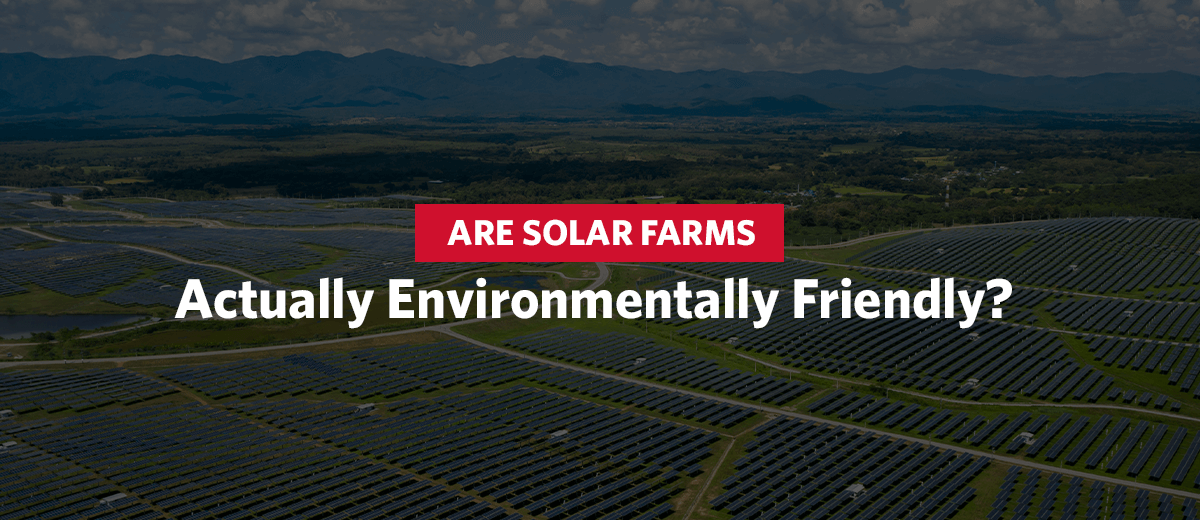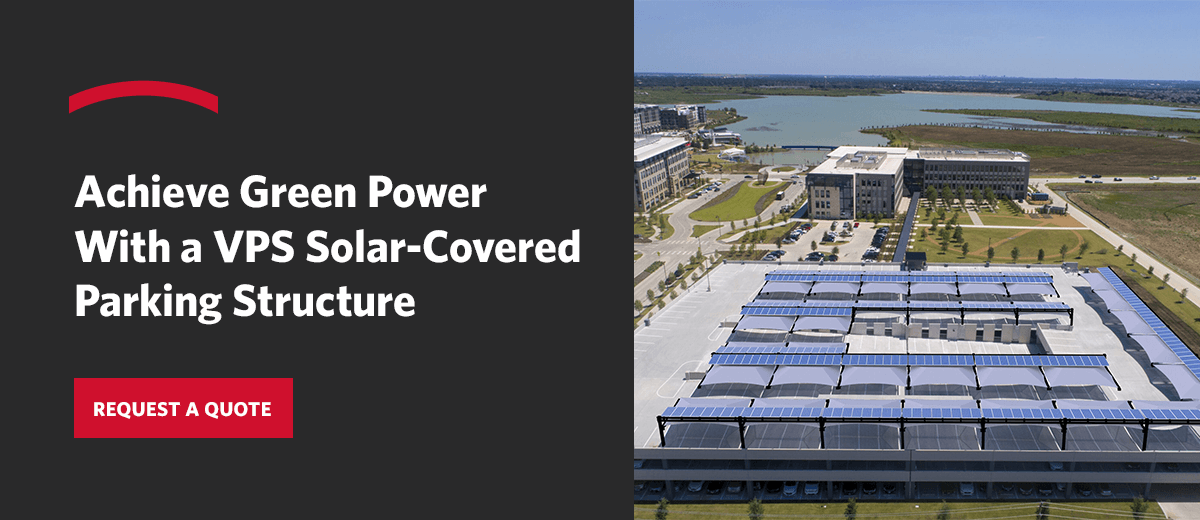Solar power is the largest power resource globally, with about 2,500 terawatts (TW) of accessible, renewable energy. To capitalize on the environmental and financial benefits of utilizing this natural source, businesses across various industries are investing in solar farms.
Because solar power is largely understood as a more eco-conscious alternative to traditional energy sources, many companies believe these farms are good for the planet. But are they actually environmentally friendly? Uncovering the truth is essential for businesses investing in solar energy solutions to push their companies in a greener direction.
Learn more about the environmental consequences of installing and managing a solar farm below.
What Are Solar Farms?
Solar farms are commercial solar power installations. They are typically separate from a business’s main facilities and work areas. Solar farms allow for larger-scale power generation and function as alternative power plants, producing and distributing electricity to homes, businesses, and industrial applications.
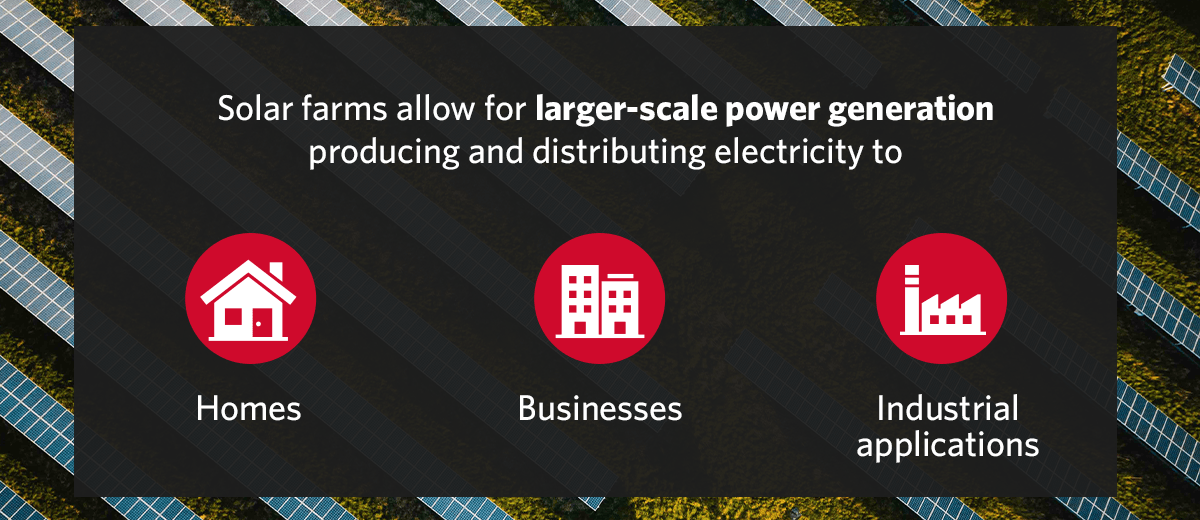
Companies are increasingly going solar to reap the green benefits of this energy — solar deployments have seen an average annual growth rate of 25% in the last decade, and these farms are helping them keep up with power demand.
However, there are alternative solar solutions that can make use of existing structures and wreak less havoc on the local environment to generate power.
How Do Solar Farms Work?
Photovoltaic (PV) panels absorb sunlight, convert it to electricity, and direct that energy to a facility, power grid, or storage system. Solar farms generally consist of many panels mounted directly to the ground, often covering an acre of land or more.
Especially large farms can exceed thousands of acres — the largest solar farm in the world is located in Xinjiang, China and covers an area similar in size to New York City. The high number of panels allows these facilities to harvest vast amounts of energy — the more panels, the more sunlight they can absorb and convert.
Solar farms have pros and cons, but are they really green? Businesses should consider a few characteristics before jumping on the solar farm bandwagon.
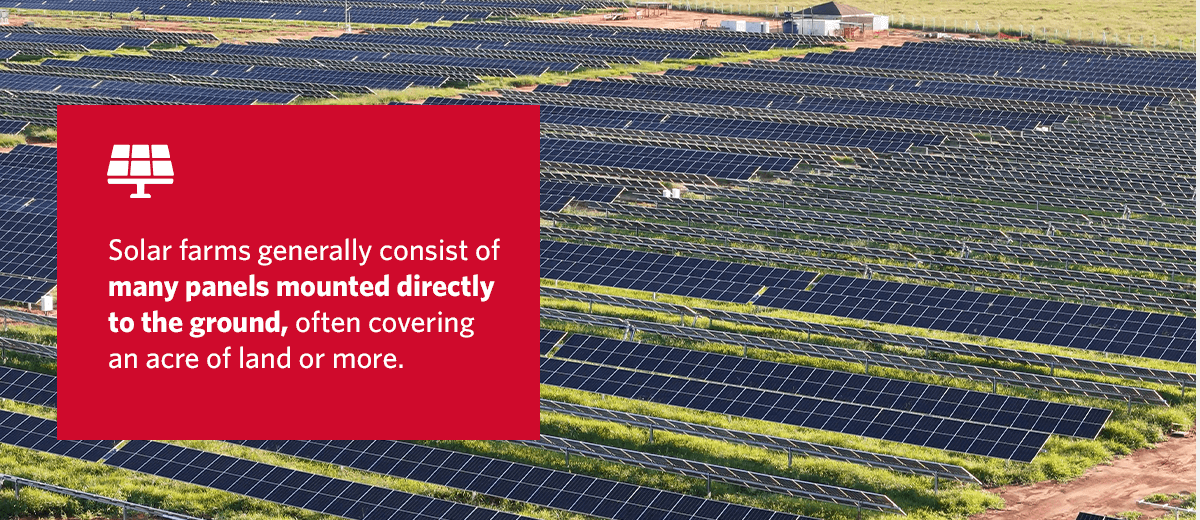
How Solar Farms Impact Land and Ecosystems
While solar power is better for the environment, its configuration and design can significantly affect its green viability. Building solar farms takes up large areas of open space, including grasslands and croplands, which impacts the ecosystem. It uses land that may be used for growing food or as habitats for local plant and animal species.
Solar farms can harm the ecosystems they are installed on. However, some companies argue that their renewable energy production and reduced carbon emissions outweigh these cons. They may also argue that undeveloped land is far away from commercial areas and cities, so buying large plots in these places is usually more affordable. It’s also easier for companies to manage their significant energy inputs if they’re all in one space.
While solar farms might be the cheaper and convenient option for major corporations, they are not the best choice for the environment.
Land Usage Consequences
While the idea of saving money in the name of solar farms may make sense, using undeveloped land when there are other options is unnecessary. Open land is a dwindling resource, and any area that can be used to grow food or support wildlife should be protected.
Individuals who reside near undeveloped land are not always happy about the prospect of solar farms taking up their surrounding community. Some argue that these farms generate excess heat and are a significant eyesore amidst the natural scenery.
One situation in Northern Indiana caused an uproar when a proposal for a massive solar farm shook the local community. Unsurprisingly, many who care about the environment are not supportive of solar farms.
Expert researchers estimate that by 2050, some countries will have to grow double the amount of food to feed the approximate 9 billion global population. There’s a desperate need for more quality terrain in areas with sufficient sunlight and natural ecosystems. Research shows that at least 33% of the food-producing land has been lost due to pollution and erosion. The world needs all the land it can get, especially areas that can be used to farm and grow crops.
Ecosystem Effects
Solar farms also have significant effects on the surrounding biomes, primarily when they’re located in ecosystem-rich areas. Here are some of the ways solar panel farm problems may trickle down to the local environment:
- Removing natural habitats: Solar farms take up large plots of land, and the construction process requires clearing and grading. It can significantly erode soil and destroy habitats that rely on the land for sustenance and survival.
- Reducing water resources: Building and operating a solar farm may require using nearby water sources for applications like dust control, site preparation, or concrete mixing. In undeveloped lands, this could strain the few current resources. There’s also a risk of chemical spills and construction waste that could potentially cause contamination and harm.
- Decreasing native species: Solar panels can alter an area’s heat and humidity levels, causing the native vegetation to die off and affecting the survival and reproduction of surrounding animal species. By changing the land, solar farms reduce the biodiversity of that area.
- Affecting air quality: The construction of solar farms can unearth soil-carried pathogens, which are carried into air particulate matter and travel to surrounding water and wildlife. The panels also heat the surrounding air, which negatively affects air quality and has a ripple effect on the area’s ecosystem.
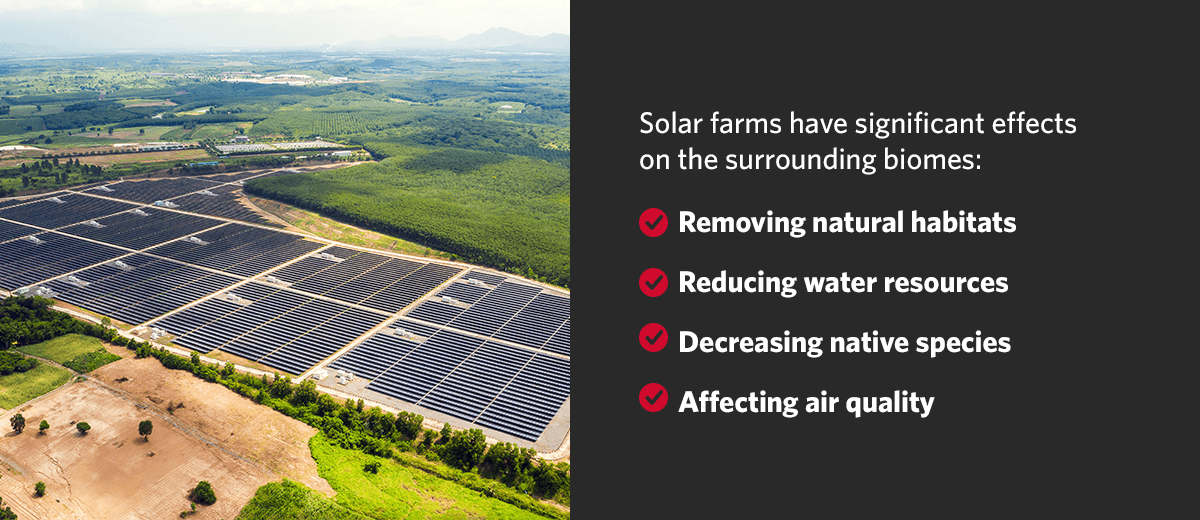
Wildlife Disruption Caused by Solar Farms
While solar solutions can provide businesses with cleaner, renewable energy sources, solar farms in areas rich in biodiversity and natural resources can negatively affect wildlife. Learn more about the potential implications below.
Bird Migration Complications
Solar farms in areas with rich wildlife or buffer zones around protected areas can cause glares and other environmental changes that confuse migrating birds. Here are the major negatives of solar farms when it comes to bird migration concerns:
- Collisions: Solar panels’ reflective surfaces can confuse birds into thinking they are open water. When they are migrating, this can affect their flying patterns and lead to them colliding with each other or the panels. In severe cases, this can cause multiple fatalities and injuries, which can deter their migration, causing a ripple effect on local bird populations.
- Habitat destruction: Solar farms remove nesting sites, migration routes, and foraging grounds to create sufficient space for large solar panels. In doing so, they destroy the natural habitats of birds of flight, which can leave them vulnerable to predator attacks and stall migration times.
- Behavioral changes: Birds of flight may rely on the ecosystem that solar farms replace. The reflective panels may force them to avoid their natural areas of habitat, which could negatively affect their mating and breeding habits. These behavioral changes may have long-term effects on bird populations and distribution.
Habitat Destruction
Solar farms take up sufficient space in undeveloped lands. The construction process is also rapid, which doesn’t give the inhabitants sufficient time to migrate and recover. One significant example is the Mojave Desert tortoise.
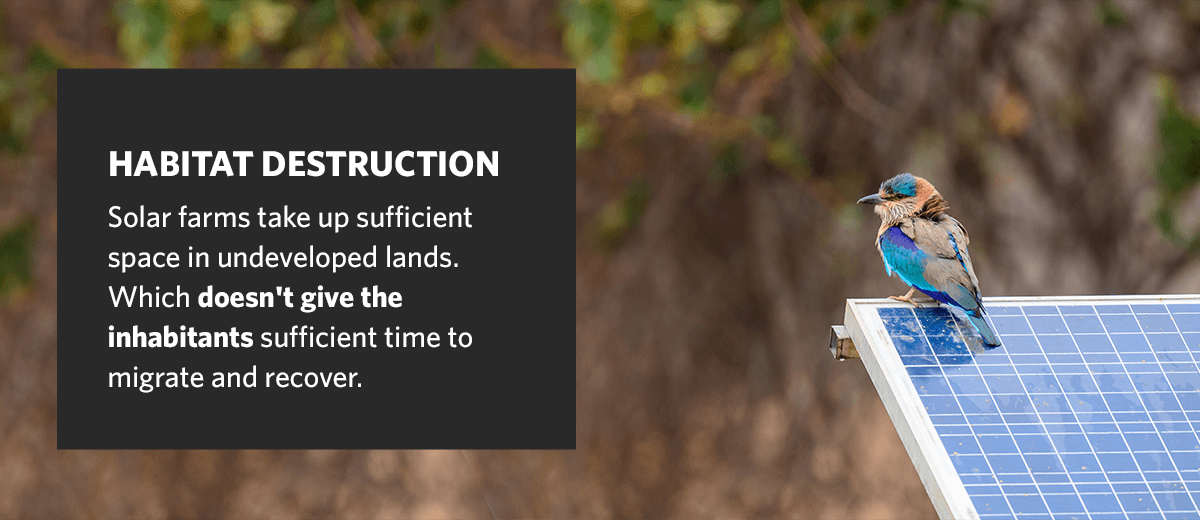
The Mojave Desert is a prime spot for solar farms because of the high rays and open land. Environmentalists are concerned about the populations of these tortoises because their natural habitats are being lost. Once these habitations are destroyed, there might be no way to recover their populations. One project in the Mojave Desert bulldozed around 600 acres of the tortoise’s natural habitat and other species like bighorn sheep and Mojave fringe-toed lizards.
Food Source Deterioration
Building solar farms on undeveloped land requires removing the above-ground vegetation that many animals rely on for food sources. Removing this greenery has a ripple effect on the entire ecosystem of an area. For example, insects won’t be able to feed, and birds won’t have insects to eat, so they’ll migrate, leaving predators without prey and affecting the entire food chain.
Noise Pollution
Undeveloped areas are usually quiet and peaceful. The construction process for solar farms requires heavy machinery and many workers. Installing the panels can be extremely loud.
Noise pollution drastically impacts animals. Research shows that loud noises can affect the reproductive rate of bluebirds and cause caterpillars’ dorsal vessels to speed up. Here are the wildlife activities that noise pollution can affect:
- Navigation: Some animal species rely on frequencies and echos to avoid obstacles and locate food sources. Noise pollution can disorient them and cause them to crash into obstacles. Prolonged noise exposure can damage their hearing abilities and make it difficult for them to locate prey. It can also cause them to adjust their call frequencies, affecting their ability to communicate or call for help.
- Breeding: For many animals, breeding happens via mating rituals, which usually require particular calls to attract the opposite sex. If the call is low-pitched, the sound can get drowned out by other low-frequency noises like vehicle engines and machinery. Some animals may raise their pitch to be heard over the noise, but this doesn’t always work out well. Certain male species may be perceived as less attractive if they’re higher-pitched, lowering their chances of getting a mate and resulting in smaller breeding pools.
- Foraging: Some animals rely on their intricate hearing to survive. They use their hearing to locate prey and stay safe from predators. Noise pollution from solar panel construction can disturb these animals and cause them to become disoriented, affecting their ability to stay safe and find food.
- Communication: Animals use distinctive calls to communicate important messages about danger and finding their offspring. Noise pollution disrupts the pitches and intervals of these essential communicative sounds. If animals cannot share important messages with each other, it could affect their ability to bond and stay safe.
Microclimate Changes From Solar Farms
Do solar farms affect the weather? Due to their large size, composition, and appearance, solar farms cause microclimate changes. The dark-colored panels cover the ground, which affects the solar reflectivity of the surface.
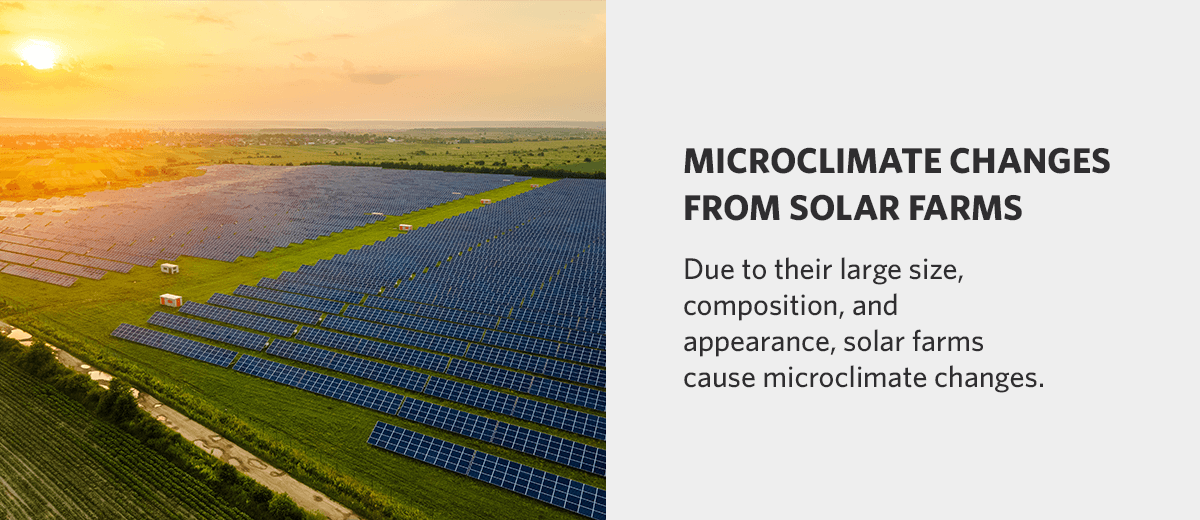
The high reflectivity of solar panels paired with the large number of panels in solar farms causes a microclimate change known as the heat-island effect. This occurs because the panels only absorb a fraction of the sunlight that reflects onto them, and the remaining energy sifts into the environment as heat.
Here are some of the key effects of these microclimate changes:
- Changing natural hydrologic processes: The heat-island effect causes the moisture levels in the soil to redistribute, which may lead to erosion in the long run. There’s also a potential for runoff generation, which could contaminate natural water sources.
- Heating the area: Solar farms generate a lot of the sun’s radiation, making them extremely hot, reaching temperatures up to 149 degrees Fahrenheit. As the surrounding air becomes hotter, it affects nearby ecosystems and wildlife.
- Decreasing or increasing vegetation: In certain locations, like the Sahara desert, large-scale solar farms may increase vegetation, whereas in other areas, like croplands, they may decrease it.
Are Microclimate Changes Always Negative?
Solar farms aren’t entirely negative. Research shows that in the right places, they can be beneficial. A climate model study revealed that if a solar farm in the Sahara filled 20% of the total area, it would likely trigger a feedback loop. The high heat emissions would create a significant temperature difference between the land and the surrounding water sources. This effect may cause condensation and eventually more monsoon rainfall. More plants would create a humid environment, potentially forming a thriving ecosystem in once-barren lands.
While this feedback loop may sound great, further studies cause room for doubt. Some scientists have found that covering 20% of the Sahara with solar farms may improve conditions in the desert but worsen conditions elsewhere. The effects could spread around the globe, causing the polar regions to warm up and the tropics to cool down. It might accelerate the effects of global warming and lead to an array of ripples, including:
- Heavy rainfall in the topics.
- Droughts in the Amazon.
- Frequent tropical cyclones, especially on East Asian and North American waters.
So, while microclimate changes, specifically those associated with the Sahara desert, may have some positive effects, they could also worsen conditions in other areas. Further studies are needed to determine whether solar farms are safe and if there are any possible environmental benefits.
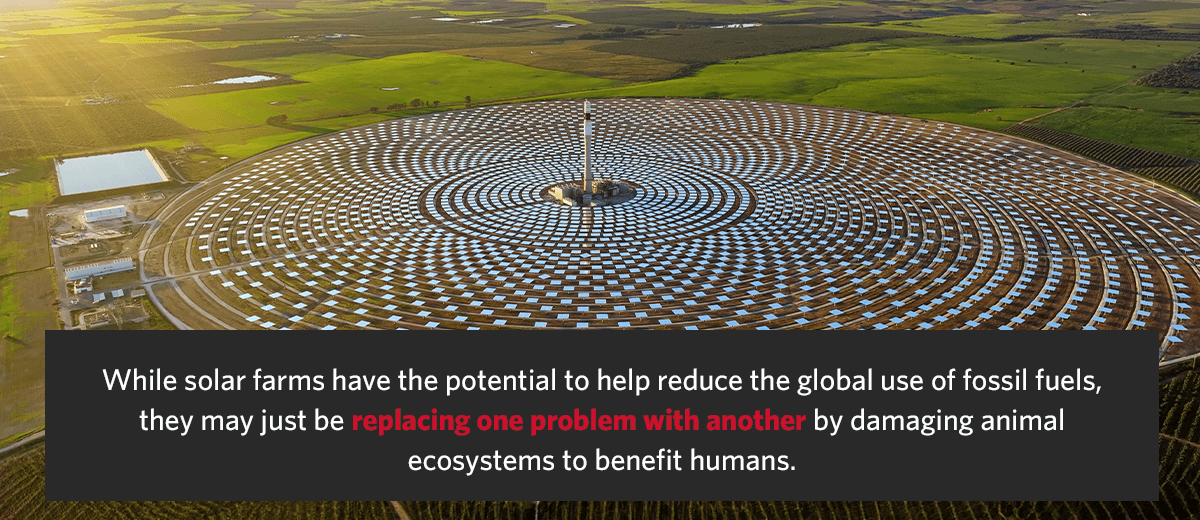
Are Solar Farms Bad for the Environment?
While solar energy is better for the environment than fossil fuels and provides humans with a renewable and green energy source, solar farms are not the best option. A large-scale observational study looked at 116 solar farms worldwide and found major land surface cooling and a significant negative impact on existing vegetation.
While solar farms have the potential to help reduce the global use of fossil fuels, the evidence thus far shows that they may just be replacing one problem with another by damaging animal ecosystems to benefit humans.
What Are the Alternatives to Solar Farms?
Solar farms allow companies to generate large amounts of power from one location. However, they damage ecosystems, affecting wildlife behavior and breeding in undeveloped areas. The best alternative is building solar structures over spaces humans have already inhabited. Building panels on parking lots is an efficient way to get green power without damaging the environment.
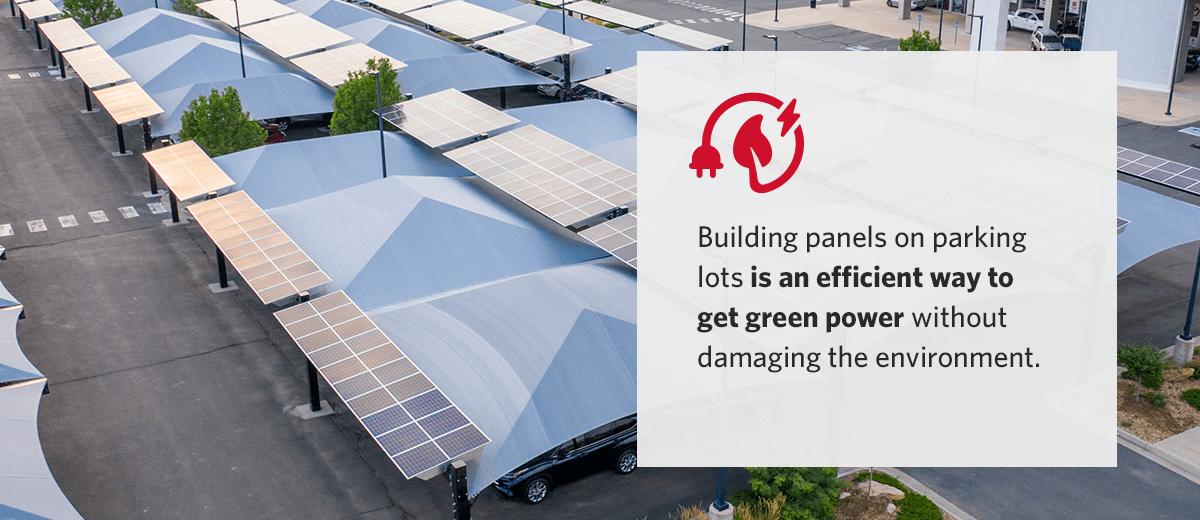
Some doubt that solar parking lots would make a significant difference, but studies show a different perspective. For example, one study found that if all the parking lots in Connecticut were covered with solar canopies, it would produce 37% of the electricity demand in the state.
Should Businesses Invest in Solar Farms or Solar Parking Lots?
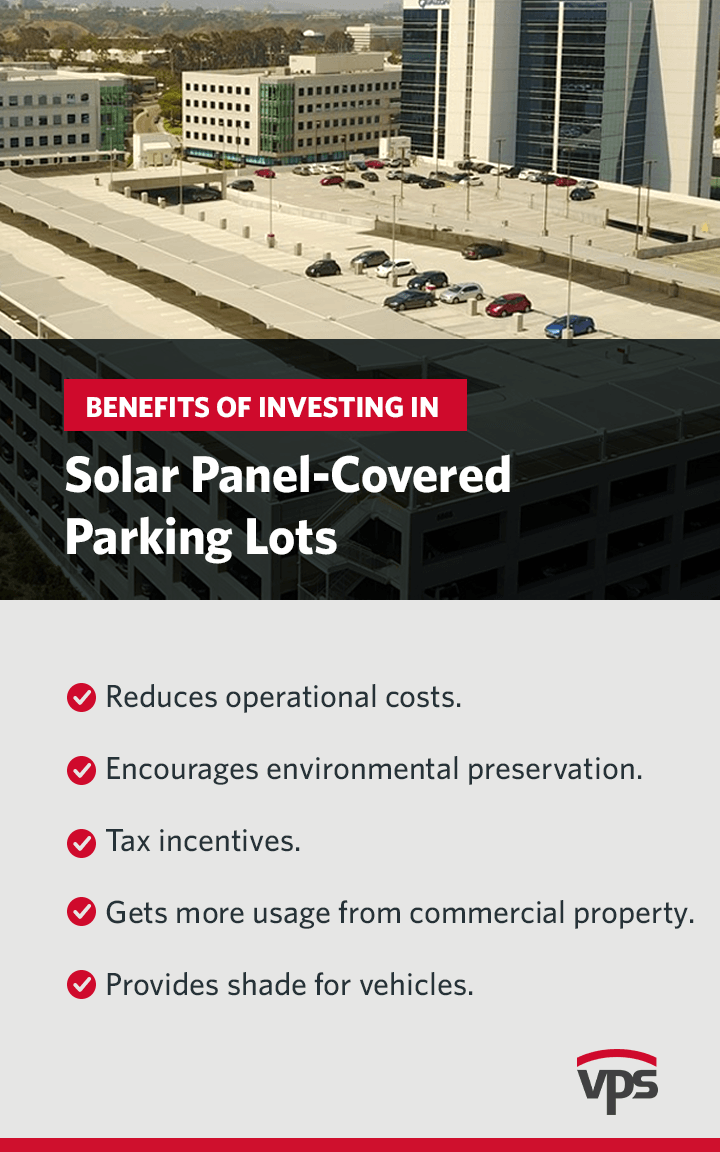
Solar parking lots are the better option for most businesses. Not only is it an opportunity for the company to embrace green energy, but there are also additional benefits of solar panel-covered parking lots, including:
- Reducing operational costs.
- Encouraging environmental preservation.
- Enjoying tax incentives.
- Getting more usage from commercial property.
- Provides shade for vehicles.
Solar parking structures can help companies achieve greener energy consumption while being versatile enough to integrate into several industries.
Here are just a few of the business types that could benefit from solar canopies:
- Car dealerships: Solar parking structures can offer a win-win situation for car dealerships. They provide renewable energy that they can use to power charging stations for electric cars. Dealerships can also benefit from the possible added vehicle protection from hail and sun damage that solar canopies bring.
- Hospitality businesses: Hotels and other accommodation facilities typically have wide entryways and parking spaces. Solar canopies can provide protected parking lots for their guests and reduce electricity costs in the long run.
- Municipalities: Government and public buildings can use solar parking structures to harness renewable energy and provide sufficient parking and waiting areas.
- Retail and restaurants: These businesses can use solar parking structures to offer customers protected parking while reaping the environmental and tax benefits of sustainable energy.
- Hospitals: Hospitals can use solar canopies to provide more secure parking for their fleet and use the energy to lower operating costs.
Key Considerations for Solar-Covered Parking Structures
If your business is interested in reaping the benefits of a solar-covered parking structure at your facility, store, or center, consider these key considerations for getting started.
Site Assessment
If your site’s parking area receives direct sunlight, solar designs are likely a suitable option. Areas that receive significant shade or feature obstructions, such as trees or nearby buildings, that interfere with sunlight during portions of the day may benefit more from traditional, non-solar cantilevers.
Design and Parking Layout
After a site assessment, consider your parking area’s design and how to integrate solar parking structures to accommodate maneuverability for drivers. Your business will likely benefit from a custom solution engineered specifically for your facility.
Regulatory Compliance
Your business must consider local solar technology and installation compliance. Research local zoning regulations and ensure you work with a professional who understands and can obtain the necessary building and electrical permits.
Working With a Trusted Provider
Do your due diligence when partnering with a solar-covered parking structure provider. Ensure they are experienced and understand installation best practices for commercial facilities.
Achieve Green Power With a VPS Solar-Covered Parking Structure
At VPS, we are the industry leader in large-scale solar panel-covered parking structures as well as hail-protection structures. We help businesses benefit from solar-powered energy by utilizing on-site property to create multi-functional solar canopies. We work with companies through every step, from conceptual design to construction and installation.
Our products can make your company stand out from competitors by embracing green energy and providing improved hail and shade protection for vehicles. We specialize in long-term asset protection solutions, and our products go beyond typical fabric-shaded options for parking lots.
If your business needs a long-term parking protection solution, contact us for a free quote, and we will be in touch shortly to address the solutions your business needs.
